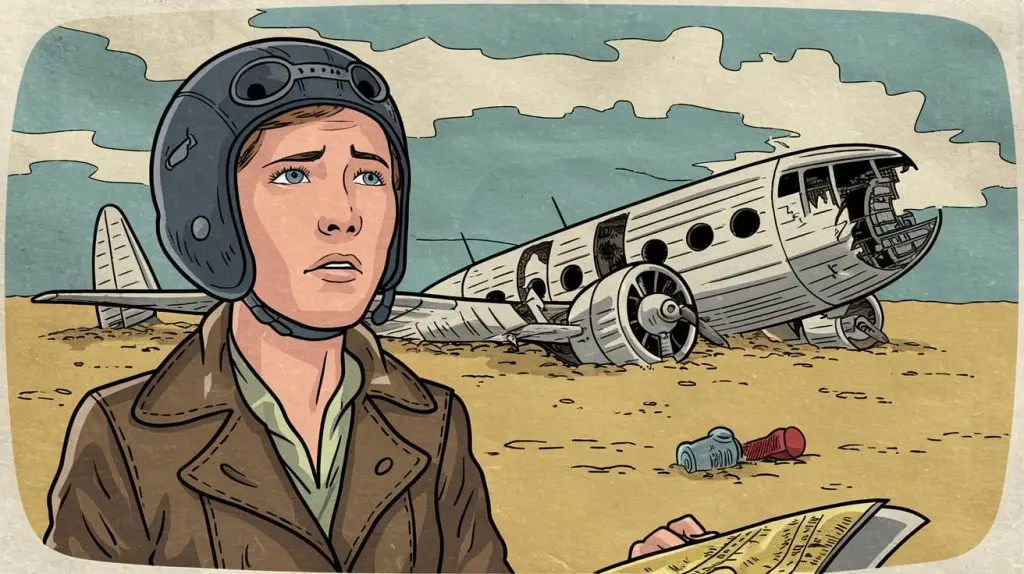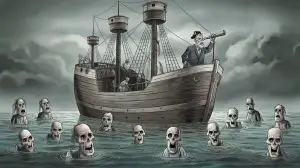The Disappearance of Amelia Earhart. Amelia Earhart’s disappearance in 1937 is one of the greatest aviation mysteries of all time. She vanished while attempting to circumnavigate the globe, leaving many to wonder what really happened.
Various theories suggest different fates, from crashing into the ocean to being a castaway or even captured.
Interest in Earhart’s story has never waned, and recent developments continue to captivate the public. An exploration team recently reported spotting what might be her long-lost plane in the Pacific Ocean. The shape and size of the object align with Earhart’s aircraft, adding a tantalizing clue to the puzzle.
People are fascinated by the unresolved aspects of her fate. Investigations and searches have spanned decades, as enthusiasts and experts alike seek to uncover the truth.
Whether she crashed, survived as a castaway, or met another end altogether, Amelia Earhart’s story endures, sparking curiosity and debate worldwide.
Early Life of Amelia Earhart
Amelia Earhart’s early years laid the groundwork for her legendary aviation career.
Beginnings and Education
Amelia Earhart was born on July 24, 1897, in Atchison, Kansas. She spent much of her childhood with her grandparents in a large house, enjoying a relatively privileged upbringing. Her parents, though supportive, had a tumultuous marriage, which influenced her early life.
She attended high school in Chicago, showing a keen interest in science and sports.
After graduation, she enrolled at Columbia University. Though she excelled, she left after a year to be closer to her family in California.
Path to Aviation
Amelia’s fascination with flying began when she visited an airshow in Toronto during World War I.
Inspired by the daring pilots, she took her first flying lesson in 1921 and was hooked immediately. Her instructor, Neta Snook, was one of the first female aviators.
Amelia worked various jobs, including photographer and truck driver, to save money for flight lessons. She eventually purchased her first plane, a bright yellow Kinner Airster. She nicknamed it “The Canary,” and in it, she set her first women’s record by flying to 14,000 feet.
The Influence of Charles Lindbergh
Charles Lindbergh’s solo transatlantic flight in 1927 ignited Amelia’s ambition to pursue her own historic flight.
Encouraged by his bravery and success, she sought similar achievements.
Her determination led her to become the first woman to fly solo across the Atlantic Ocean in 1932, just like Lindbergh.
Amelia’s drive was fueled by the admiration she had for Lindbergh’s technical skill and courage. His flight proved such feats were possible, and she aimed to prove that women, too, could achieve them. This eventually cemented her legacy as a trailblazer in aviation.
Milestones in Earhart’s Career
Amelia Earhart’s career is marked by groundbreaking achievements and barrier-breaking moments.
First Female Aviator Accomplishments
Earhart became a standout figure in aviation history. In 1922, she set a record by flying solo to an altitude of 14,000 feet. This achievement was just the beginning.
In 1932, she became the first woman to fly solo nonstop across the Atlantic Ocean, a feat that earned her international fame. Throughout her career, she accumulated numerous awards and recognitions that celebrated her pioneering spirit and contributions to the field of aviation.
Solo Transatlantic Flight
One of Earhart’s most famous accomplishments was her solo transatlantic flight in 1932.
She took off from Newfoundland, Canada, and landed in Ireland, flying a Lockheed Vega 5B. The journey took about 15 hours.
This historic flight made her the first woman to fly solo across the Atlantic Ocean. This dramatic feat not only boosted her fame but also inspired countless women to pursue careers in aviation and other male-dominated fields.
Formation of The Ninety-Nines
In 1929, Earhart co-founded The Ninety-Nines, an international organization of female pilots. This group aimed to support and advocate for women in aviation.
The name “Ninety-Nines” was chosen to represent the 99 charter members. Earhart served as the first president, setting the groundwork for future generations of female aviators.
The organization still exists today, providing networking, education, and advocacy for women in the field of aviation.
The Final Flight

Amelia Earhart’s final flight was a daring attempt to circumnavigate the globe, an ambitious feat for any pilot at the time. Key moments unfold from her planning stages, her departure from California, and her last known flight from Lae to Howland Island.
Planning and Preparation
Amelia Earhart and her navigator, Fred Noonan, put a lot of effort into planning this flight.
They chose a Lockheed Electra, a twin-engine monoplane with advanced navigation tools for the journey.
Their route would take them around the world close to the equator, covering about 29,000 miles.
Detailed maps and charts were studied to plan for refueling stops, most notably Howland Island, a tiny spec in the Pacific Ocean.
Earhart made her first attempt in March 1937 but had to abandon it due to damage to her aircraft. After repairs, she was ready for her second attempt in May 1937.
The extensive preparation reflected their determination and meticulousness.
From California to Miami
The journey began on May 21, 1937, when Earhart took off from Oakland, California.
She flew eastward, making several stops along the way. These included Tucson, Arizona, and New Orleans, Louisiana.
Arriving in Miami, Florida, marked the official start of her global flight.
In Miami, she made final adjustments to her plane and used the opportunity to engage with the press. This helped to drum up support and boost her morale.
Earhart and Noonan showed confidence, despite the risks and challenges ahead.
Lae to Howland Island
The last leg began on July 2, 1937, from Lae, New Guinea, heading to Howland Island.
This was one of the most challenging stretches due to its length—about 2,556 miles—and the remoteness of the destination.
Earhart’s radio transmissions indicated she was battling overcast skies and rain showers.
Unfortunately, she was unable to establish clear radio communication with the Coast Guard ship, USCG Itasca, stationed at Howland Island to guide her in.
The last messages suggested she was low on fuel and struggling to find the island.
No one knows for sure what happened next. It’s believed she and Noonan ran out of fuel and were forced to ditch into the ocean.
This tragic ending turned her flight into one of history’s greatest mysteries.
The Disappearance

Amelia Earhart’s disappearance on her flight over the Pacific Ocean in 1937 has captivated people for decades. Mysteriously vanishing without a trace, theories about Earhart and her navigator Fred Noonan abound.
The Journey Across the Pacific Ocean
Amelia set off on a daring attempt to circle the globe in her Lockheed Electra 10E.
She and her navigator, Fred Noonan, had already flown a significant part of their journey when they hit the most challenging leg: across the vast Pacific Ocean.
Their goal was to reach Howland Island, a tiny speck in the ocean.
The U.S. Coast Guard Cutter Itasca was ready to help guide them in, but Amelia and Fred never made it. Fuel worries loomed large during this stretch, adding to the tension and danger.
Lost Contact with the Coast Guard Cutter Itasca
Communication was crucial for the success of their Pacific leg.
The Itasca was supposed to be their lifeline. They exchanged a few brief messages, but things soon went silent.
The Itasca and Earhart struggled with technology of the time.
The last known message from Amelia indicated she couldn’t find Howland Island and was running low on fuel. The Itasca crew listened eagerly, but no more signals came. All they had left was an overwhelming silence.
The Search for Earhart and Noonan
After losing contact, a massive search operation began.
The U.S. Navy and Coast Guard scoured the Pacific Ocean, covering thousands of miles.
The searchers faced a Herculean task, combing through endless waves and remote islands.
Despite their efforts, no conclusive evidence of the fate of the Electra, Earhart, or Noonan was found.
Their disappearance remains one of the great unsolved mysteries. Today, theories continue to pop up, making people wonder about what truly happened to this pioneering aviator and her navigator.
Theories and Investigations
Amelia Earhart’s mysterious disappearance has captivated people for decades. Various theories have arisen, each competing to explain her fate. Let’s take a closer look at the most intriguing ideas.
Crash and Sink Theory
This explanation suggests Earhart’s plane ran out of fuel and crashed into the Pacific Ocean.
With no land in sight, some experts believe the aircraft would have quickly sunk.
Various searches, including sonar scans of the ocean floor, have been conducted to find the wreckage. To date, no conclusive evidence has been found.
Elgen Long, a retired pilot, is a notable supporter who has spent decades researching this theory, noting that the plane would’ve had to float a long way.
The Gardner Island Hypothesis
Known today as Nikumaroro, Gardner Island is central to another leading theory.
It proposes that Earhart and her navigator, Fred Noonan, landed there and eventually perished.
The island is uninhabited and located in the Pacific Ocean.
Several expeditions have found artifacts, including possible aircraft debris and even bones believed by some to be Earhart’s. Though compelling, the evidence hasn’t been definitive enough to close the case.
Japanese Capture Scenario
This theory is perhaps the most dramatic.
It suggests that Earhart’s plane crash-landed on an island controlled by Japanese forces.
According to some conspiracy theories, Earhart and Noonan were captured and held as spies.
Stories circulate about their supposed imprisonment, with some even claiming they were executed or died in captivity.
Speculation goes so far as to suggest Earhart was later secretly repatriated to New Jersey under an assumed name.
Legacy and Impact
Amelia Earhart’s legacy extends far beyond her aviation achievements. Her contributions to women’s rights, the ongoing efforts to solve the mystery of her disappearance, and her cultural recognition have solidified her place as a legendary figure.
Amelia’s Contribution to Aviation and Feminism
Amelia Earhart was a pioneer for both aviation and the feminist movement. She was the first woman to fly solo across the Atlantic, breaking gender barriers in a male-dominated field.
Amelia’s achievements proved that women could excel in aviation, inspiring a generation of female aviators.
She was also a strong advocate for women’s rights. Amelia encouraged women to pursue careers in fields traditionally dominated by men. Her bold stance on independence and equality made her an icon for feminists everywhere.
The Continuation of the Search
The mysterious circumstances of Amelia Earhart’s disappearance have fueled ongoing interest and speculation.
Numerous expeditions have been launched in hopes of finding clues about her fate. Some researchers believe she crash-landed on a remote island and survived for a time, while others think her plane simply ran out of fuel and sank.
Organizations like the International Group for Historic Aircraft Recovery (TIGHAR) continue to investigate. They analyze fragments and artifacts, keeping Amelia’s story alive.
The search persists, driven by the desire to solve one of history’s greatest aviation mysteries.
Cultural Influence and Recognition
Amelia Earhart’s influence permeates cultural realms far and wide. Her story has been immortalized in books, movies, and documentaries.
Libraries worldwide house collections dedicated to her life and achievements, ensuring that her legacy is studied and celebrated.
She is recognized as a legendary figure whose determination and courage resonate with people of all ages.
Statues and memorials stand in her honor, and her name graces airports and schools. Amelia’s story continues to inspire and capture the imagination, making her a timeless figure in American history.
Modern Exploration and Discoveries
Over the years, the search for Amelia Earhart’s plane has involved innovative methods and modern technology. Groups like TIGHAR and Nauticos have led these efforts with exciting findings.
TIGHAR’s Expeditions
The International Group for Historic Aircraft Recovery (TIGHAR) has been a major player in the search for Earhart’s plane.
They have conducted multiple expeditions to Nikumaroro, a remote island in the Pacific Ocean, where they believe Amelia Earhart and her navigator, Fred Noonan, might have landed.
Their research includes analyzing historical records, old photographs, and physical artifacts.
They have found items like a piece of aluminum, which could be from her plane. While no conclusive evidence has been found, TIGHAR’s efforts have kept the mystery alive and brought in new clues.
Deep-Sea Explorations by Nauticos
Nauticos, a deep-sea exploration company, has taken a different approach by focusing on the ocean floor.
Using advanced sonar and underwater vehicles, they have scanned vast areas of the Pacific Ocean.
One of their significant discoveries was a sonar image of an anomaly at 16,000 feet, which resembles an aircraft.
This has sparked excitement among researchers, although further verification is still needed.
The use of deep-sea vision technology allows them to explore areas previously unreachable, making their contributions invaluable.
Emerging Technology and Historical Insight
Modern technology has drastically changed how we search for historical wreckage.
Sonar and deep-sea imaging tools can reveal objects buried under layers of sand and silt.
Teams have used tools like underwater drones to capture detailed images of possible sites.
Historical data, like navigation logs and eyewitness accounts, are also being re-evaluated with fresh perspectives provided by technology.
For instance, computer models now help map potential crash sites.
The integration of historical insight with cutting-edge tech has rejuvenated the hunt for Earhart’s plane, offering new hope with each expedition.
Amelia Earhart’s Cultural Legacy
Amelia Earhart wasn’t just a talented female aviator; she became a beacon of inspiration for many. Her adventurous spirit and groundbreaking achievements have left a lasting mark on art, literature, and popular imagination.
Inspiration in Arts and Literature
Amelia Mary Earhart’s life has inspired countless works.
Books like “The Fun of It,” penned by Earhart herself, offer an inside look into her adventures and advocacy for women’s rights.
Her story has also sparked fiction and non-fiction works, including biographies and novels.
Art pieces depicting her brave flights and iconic images have been showcased in galleries.
Painters and sculptors celebrate her figure, capturing her essence as a pioneering woman.
Plays and films further immortalize her, with actresses taking on the challenge of portraying her indomitable spirit.
Permanent Imprint on Popular Imagination
Earhart’s disappearance is one of the 20th century’s great mysteries. It has fueled numerous theories and searches. This intrigue keeps her in the public eye. It also spurs documentaries and investigative shows.
The legend of her fate is a topic of conversation. It remains prominent in aviation history discussions. Her name is synonymous with courage and adventure. She is a true hero who dared to defy the norms of her time.
Popular culture continuously references her. Her story appears in TV shows, music, and advertisements. The allure surrounding her vanished flight amplifies her mystique. This ensures that her legacy continues to captivate and inspire new generations.
Steve is the creative force behind My Unique Tales, a blog dedicated to sharing captivating stories that explore the human experience in all its complexity. With a passion for writing and a talent for crafting engaging narratives, Steve's blog is a treasure trove of imaginative tales that transport readers to other worlds and challenge them to see things from new perspectives. From epic adventures to intimate character studies, Steve's stories are always thought-provoking and emotionally resonant. With a growing following of readers who appreciate his unique voice and creative vision, Steve is quickly becoming a rising star in the world of online storytelling.






